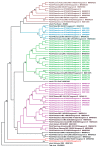Differential Cytokine Responses and the Clinical Severity of Adult and Pediatric Nephropathia Epidemica
- PMID: 37108178
- PMCID: PMC10139191
- DOI: 10.3390/ijms24087016
Differential Cytokine Responses and the Clinical Severity of Adult and Pediatric Nephropathia Epidemica
Abstract
Nephropathia epidemica (NE), caused by the hantavirus infection, is endemic in Tatarstan Russia. The majority of patients are adults, with infection rarely diagnosed in children. This limited number of pediatric NE cases means there is an inadequate understanding of disease pathogenesis in this age category. Here, we have analyzed clinical and laboratory data in adults and children with NE to establish whether and how the disease severity differs between the two age groups. Serum cytokines were analyzed in samples collected from 11 children and 129 adult NE patients during an outbreak in 2019. A kidney toxicity panel was also used to analyze urine samples from these patients. Additionally, serum and urine samples were analyzed from 11 control children and 26 control adults. Analysis of clinical and laboratory data revealed that NE was milder in children than in adults. A variation in serum cytokine activation could explain the differences in clinical presentation. Cytokines associated with activation of Th1 lymphocytes were prominent in adults, while they were obscured in sera from pediatric NE patients. In addition, a prolonged activation of kidney injury markers was found in adults with NE, whilst only a short-lasting activation of these markers was observed in children with NE. These findings support previous observations of age differences in NE severity, which should be considered when diagnosing the disease in children.
Keywords: cytokine; nephropathia epidemica; pediatric.
Conflict of interest statement
The authors declare no conflict of interest.
Figures






Similar articles
-
Cytokine, Chemokine, and Metalloprotease Activation in the Serum of Patients with Nephropathia Epidemica from the Republic of Tatarstan and the Republic of Mordovia, Russia.Pathogens. 2021 Apr 27;10(5):527. doi: 10.3390/pathogens10050527. Pathogens. 2021. PMID: 33925451 Free PMC article.
-
Clinical course of hantavirus-induced nephropathia epidemica in children compared to adults in Germany-analysis of 317 patients.Pediatr Nephrol. 2019 Jul;34(7):1247-1252. doi: 10.1007/s00467-019-04215-9. Epub 2019 Mar 14. Pediatr Nephrol. 2019. PMID: 30874941
-
Δccr5 Genotype Is Associated with Mild Form of Nephropathia Epidemica.Viruses. 2019 Jul 23;11(7):675. doi: 10.3390/v11070675. Viruses. 2019. PMID: 31340562 Free PMC article.
-
Radiological findings and their clinical correlations in nephropathia epidemica.Acta Radiol. 2007 Apr;48(3):345-50. doi: 10.1080/02841850701199629. Acta Radiol. 2007. PMID: 17453509 Review.
-
The pathogenesis of nephropathia epidemica: new knowledge and unanswered questions.Antiviral Res. 2013 Dec;100(3):589-604. doi: 10.1016/j.antiviral.2013.10.001. Epub 2013 Oct 12. Antiviral Res. 2013. PMID: 24126075 Review.
Cited by
-
Glomerular Injury Is Associated with Severe Courses of Orthohantavirus Infection.Pathogens. 2024 Aug 16;13(8):693. doi: 10.3390/pathogens13080693. Pathogens. 2024. PMID: 39204293 Free PMC article.
References
-
- Khismatullina N.A., Karimov M.M., Khaertynov K.S., Shuralev E.A., Morzunov S.P., Khaertynova I.M., Ivanov A.A., Milova I.V., Khakimzyanova M.B., Sayfullina G., et al. Epidemiological dynamics of nephropathia epidemica in the Republic of Tatarstan, Russia, during the period of 1997–2013. Epidemiol. Infect. 2016;144:618–626. doi: 10.1017/S0950268815001454. - DOI - PubMed
-
- Davidyuk Y., Shamsutdinov A., Kabwe E., Ismagilova R., Martynova E., Belyaev A., Shuralev E., Trifonov V., Savitskaya T., Isaeva G., et al. Prevalence of the Puumala orthohantavirus Strains in the Pre-Kama Area of the Republic of Tatarstan, Russia. Pathogens. 2020;9:540. doi: 10.3390/pathogens9070540. - DOI - PMC - PubMed
-
- Moore R.A., Griffen D., StatPearls (Internet) Treasure island (FL) StatPearls Publishing; 2022 Jan. Hantavirus Syndrome. (Updated 2022 May 15) [(accessed on 1 November 2020)]; Available online: https://www.ncbi.nlm.nih.gov/books/NBK513243.
MeSH terms
Substances
Grants and funding
LinkOut - more resources
Full Text Sources
Medical

